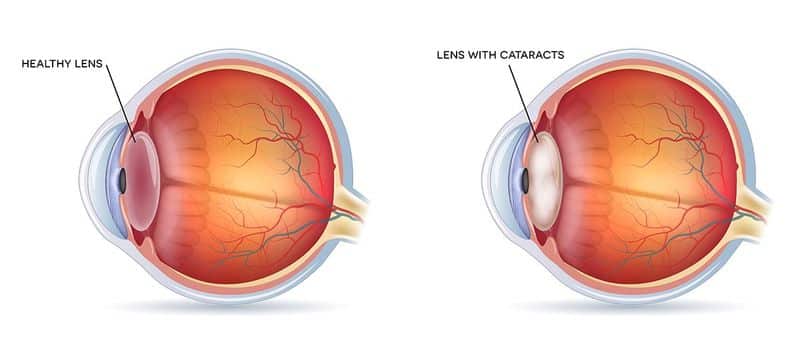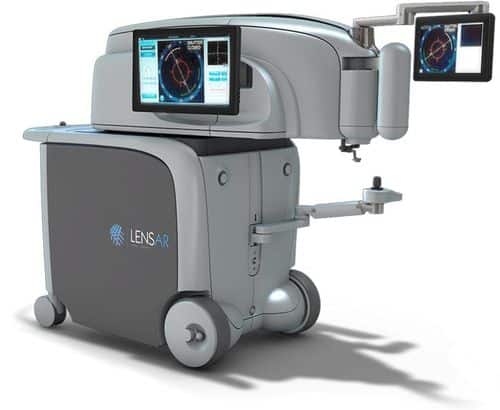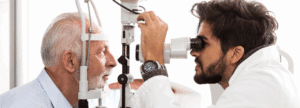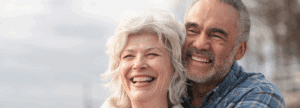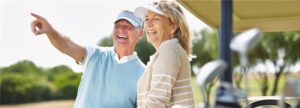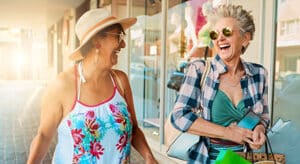Home » Beltline Surgery Center » Cataract Surgery
What Are Cataracts?
Cataracts are a common eye condition characterized by clouding of the eye’s lens, the transparent film that focuses the images as seen by the eye on the light-sensitive retina at the back of the eye. This condition usually occurs when proteins form abnormal clumps in the lens. When these clumps enlarge, they begin to interfere with vision by distorting the passage of light through the lens. The result is an increasing cloudiness that affects vision, especially at night.
At Sweeney Eye Associates, cataract surgery and diagnosis is one of our specialties. In fact, Dr. Patrick Sweeney and Dr. Vincent Venincasa have received specialized training in cataract surgery, ensuring you’re in the best hands when it comes to addressing this common vision problem.
What Are The Causes Of Cataracts?
The effects of aging, combined with lifelong sun exposure, cause cataracts to develop usually beginning around age 40. The cloudiness progresses slowly, not usually affecting vision until after the age of 60. Other contributing factors to the development of cataracts are smoking, eye trauma, chronic diabetes, radiation treatments, and corticosteroid medications. Cataracts can be present in infants at birth, usually due to infection, but those cases are very rare.
What Are Cataract Symptoms?
Typically, cataracts manifest no symptoms until the protein clumps have grown large enough to affect the patient’s vision. Because the development is very gradual, patients often don’t realize they have cataracts. But when they reach a certain point of development, various symptoms will show themselves: cloudy, blurry vision; double vision; seeing halos around lights; inability to see bright color; increased sensitivity to glare; and distortion, which can be akin to looking at the world through a veil.
How are cataracts treated?
At Sweeney Eye Associates, we offer laser assisted cataract surgery using the LENSAR® Laser System. This technology is specifically designed for cataract surgery, this femtosecond laser allows our cataract surgeons to create the optimal corneal incision, gently fragment your cloudy eye lens and remove it in a more precise and efficient manner than the traditional manual method. The cloudy lens is removed and the new intraocular lens (IOL) is placed through the same corneal incision.
Are You Having The Onset Of Cataracts?
What Are Intraocular Lenses (IOLs)?
At Sweeney Eye Associates, in addition to the safety and precision of laser-assisted cataract removal, we offer multiple lens implant options (IOLs) for our patients undergoing advanced cataract surgery, including the latest premium lens implants, allowing patients to see far, near and everything in-between with little to no dependance on glasses, contacts, readers or bifocals.
At Sweeney Eye Associates, we will discuss all your options for your cataract IOL replacement. We’ll show you all the options out there and help you choose a lenses that is best for your personal best vision.
Read Our Reviews
After suffering with cataracts, I chose Sweeney Eye Associates for my cataract surgery. I elected to undergo laser cataract surgery with an upgraded lens implant. Now I can see at all distances, even up close without glasses!
Joseph B.
Cataract Patient
Read Our Reviews
I have worn thick glasses or hard contacts my entire life! After undergoing surgical vision correction with Refractive Lens Exchange, I can see young again! No Glasses, No Contacts, No Problems!
Jennifer S.
Refractive Lens Exchange Patient
What is the treatment for cataracts?
There is no “treatment” for cataracts. The only remedy is to have the clouded natural lens surgically removed and replaced with an intraocular artificial lens. Not all cataracts need immediate treatment. The severity of your vision impairment is the deciding factor. When everyday actions like driving at night and recognizing faces becomes difficult, it is time to opt for surgery with Dr. Sweeney or Dr. Venincasa.
If you have cataracts in both eyes, the surgery is performed separately for each eye, allowing the first eye to recover with its new lens before removing the second bad lens. The second surgery will usually follow two to four weeks after the first.
What can I expect after my cataract surgery?
Cataract surgery is usually an outpatient procedure performed under local anesthesia. The procedure often takes no longer than 10 minutes to perform. Then, you will recover for 30 minutes or so and be taken home (you can’t drive yourself) with a pair of dark sunglasses to protect your eye from bright light. At home you will wear a protective shield over your eye when you sleep.
Many patients report clear vision within several hours after cataract surgery, but everyone heals differently. It can take a week or two to really see things in the sharpest focus. Until then, there can be some blurry vision, as your eye adjusts to the removal of the cataract and the intraocular lens that replaced it. There is not usually any pain associated with recovery.
Frequently Asked Questions
Learn More About Cataracts From our Blogs:
Not All Cataracts Need Surgery—Here’s How to Know What’s Right for You If you’ve been told you have a cataract, you might feel uncertain about what comes next. At Sweeney Eye Associates, with convenient locations in both Richardson and Sunnyvale, Texas, we want to make one thing clear: not all cataracts require surgery right away….
Cataract surgery has advanced dramatically in the last decade. It’s one of the most common, and successful, procedures in the world today. And yet, many people still have outdated ideas about what cataracts are, how surgery and recovery works, and when it should happen. At Sweeney Eye Associates, with offices in Sunnyvale and Richardson, we’re…
Experiencing Blurry Vision After Cataract Surgery? It Might Be a Normal Change — and It’s Easy to Treat If you’ve had cataract surgery and are now noticing blurry vision again, or your eye doctor mentioned something called a YAG laser procedure, there’s no need to worry. This is not uncommon, and in many cases, it’s…
At Sweeney Eye Associates, we understand that choosing cataract surgery is a big decision—and we’re proud to offer one of the most advanced options available today: Femtosecond Laser-Assisted Cataract Surgery (FLACS). This breakthrough technology adds a new level of precision, safety, and customization to the cataract surgery experience. What Is FLACS? Femtosecond Laser-Assisted Cataract Surgery…
REGAINING CLEAR VISION STARTS HERE Cataract surgery is one of today’s most effective and life-changing procedures. At Sweeney Eye Associates, our board-certified cataract surgeons—Dr. Patrick Sweeney and Dr. Vincent Venincasa—provide advanced care using the latest technology at the trusted Beltline Surgery Center in Dallas County. The procedure itself is quick and painless, but understanding the recovery timeline helps you prepare…
An Interview With Dr. Vincent Venincasa Had LASIK or PRK Before? Is the Effect Wearing Off or Have You Developed a Cataract? You’re not alone. Millions of people have benefited from LASIK, enjoying years of clear, glasses-free vision. However, like everyone, LASIK patients can eventually develop age-related cataracts, which affect vision over time. When it comes to…
Refractive Lens Exchange (RLE) is a revolutionary procedure that not only corrects your vision but also offers the unique advantage of preventing cataracts in the future. If you’re over 40 and considering options to improve your vision, RLE might be the perfect solution for you. In this blog, We’ll explore how RLE works, who can…
As leaders in ophthalmology, Sweeney Eye Associates understands the importance of finding a skilled and experienced surgeon for your cataract surgery. If you are looking for what to look for when choosing the best cataract surgeon, you have come to the right place. From educational background and surgical experience to technological advancements and patient-centered care, we are committed to…
Embrace Personalized Vision with Advanced Light Adjustable Lenses At Sweeney Eye Associates, we’re dedicated to keeping you informed about the latest advancements in cataract surgery. Today, we want to dive into the realm of personalized vision correction with Light Adjustable Lenses (LAL), an innovative technology that is reshaping the way we approach post-cataract surgery vision…
The team at Sweeney Eye Associates wants to empower you to make the most of your dollars, especially when it comes to ophthalmology procedures. While we recommend you consult with a qualified tax professional, we can help you learn where you can save on procedures and how you can use pre-tax dollars to plan for…
A Friendly on Discussion Laser-assisted Cataract Surgery with Dr. Patrick Sweeney: Laser-assisted cataract surgery represents a leap forward in precision and patient comfort, but patients don’t always fully understand what makes laser cataract surgery the gold standard for cataract care. Dr. Patrick Sweeney sheds light on this procedure with his top 3 reasons why any…
Cataract surgery can change your life. Not only can it give you your vision back by removing your cataracts, but it can also help you see better than ever. When you get cataract surgery, your natural lens will be removed and replaced with an intraocular lens, or IOL. Some IOLs, which fall under the premium…
Do you love the idea of clearer vision without glasses or contact lenses to see? You can thank laser vision correction procedures, which have existed for quite some time. The first laser vision correction procedure took place over 30 years ago. Medical science has made quite a few advances in that time. Vision correction procedures…
If you’re going to have cataract surgery, a crucial component of the procedure is deciding what kind of IOL you want. Cataract surgery removes cataracts by removing your eye’s natural lens, where the cataract has formed. However, removing the natural lens would make you unable to see clearly because you don’t have a lens in…
Greetings from Sweeney Eye Associates! With locations in both Sunnyvale and Richardson, TX, we strive to provide cutting-edge care for all our patients. Today, we’ll be talking about a significant advancement in cataract treatment—laser cataract surgery. Traditional cataract surgery is performed manually, with the surgeon using a handheld instrument to create a small incision in…
Cataract surgery involves removing the clouded natural lens of the eye and replacing it with an artificial lens, known as an intraocular lens (IOL). This new lens becomes a permanent part of your eye and can significantly improve your vision. While a standard IOL can significantly improve your vision, premium lens options provide additional features…
A cataract is a condition that affects the eye’s natural lens, which lies behind the iris and the pupil. The lens works much like a camera lens, focusing light onto the retina at the back of the eye, and adjusting the eye’s focus to let us see things clearly both up close and far away….

